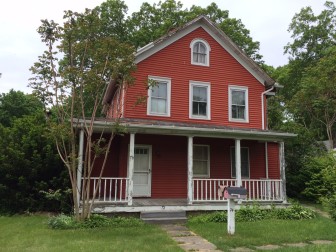A town resident and historic preservationist has filed a formal objection to the razing of a multi-family house on Forest Street that once was cited for blight.

74 Forest St. in New Canaan, photo taken May 21, 2015. Credit: Michael Dinan
The red-painted, 2,500-square-foot house at 74 Forest St.—the fifth residence on the west side of the street, running north out of downtown New Canaan—dates to 1829, tax records show.
The property in July was purchased for $603,750 by a limited liability company whose principals are James and Gregory Demirjian of New Canaan, according to records on file with the Connecticut Secretary of the State. It was transferred the following month to a different LLC controlled by the same two individuals. It isn’t clear what is planned for the lot—no building permit application has yet come into the town.
According to Mimi Findlay, the house, by the town’s own standards, is “of an age, style, condition or character that is of historical, architectural or cultural significance to the Town of New Canaan.”
That’s the criteria, laid out in the Town Charter, for the Historical Review Committee to consider at a public hearing scheduled for 10 a.m. Monday.
Findlay, chairman emerita of the New Canaan Preservation Alliance, said in a Nov. 28 letter to Chief Building Official Brian Platz that the original home dates to about 1830 and was remodeled in 1880. Citing a 1987 survey, Findlay reported that the Colonial “has been altered in the Italianate style and a Queen Anne bay has been added to the north.”
“The ground floor is shaded by a Tuscan columned porch with bull’s eye decoration on the architrave,” Findlay said in her letter.
The original section of the home was “built by Woolsey Burtis before 1836, but it was extensively remodeled by his grandson, James Burtis, partner in the retail grocery concern Burtis and Mead.”
Its significance is “in the remaining architectural features, and with its neighbor to the north, they represent the original residential houses on Forest Street, of which several remain,” Findlay said. “The street was the original road leading from the little village of New Canaan to the main road toward the northeast and to Wilton.”
According to Findlay, the proposed demolition “is an example of the removal of so many of these small, early 19th century houses in town.
“The town’s heritage is being eroded to the detriment of our village charm: to remain livable for all of us, we require human scale, access to light, air and open space as well as touchstones to our cultural past. These dense developments, such as on Park Street and Forest Street, are showing disregard for the public purpose of our zoning laws.”
By Charter, an objection to demolition must be lodged with the town Building Official within 15 days of publication of a notice of intent demolish.
If the Historical Review Committee—its members are Mike Farrell, Laszlo Papp, Ed Vollmer, Martin Skrelunas and Rose Scott Long—finds that the structure does have the “historical, architectural or cultural significance,” then it can issue a 90-day stay.
Locals will recall that that’s what happened in March 2016 with the planned demolition of an antique home on Ferris Hill Road. Ultimately, that 1735-built house was sold on and spared the wrecking ball.
The house at 74 Forest St. started making headlines in the spring of 2015, when town officials after several years of receiving complaints from neighbors, cited it for blight. Officials in making that determination found that its roof was deteriorating and no longer performing its function, that garbage and debris could be seen inside a garage when its door is open, that paint was peeling from the porch and other areas of the home’s exterior and overgrown shrubbery and an unkempt yard were visible—all from either the public way or adjoining properties.
The home on Forest Street predates the road itself, according to records on file at the New Canaan Historical Society.
According to a database detailing the origins of New Canaan street names compiled by the nonprofit organization, Forest Street “was begun in 1858 when the town laid out one block northward from the old tanyard of Frederick Ayres on the north side of Clapboard Hill Road (modern-day East Avenue) to the dooryard of George Armstrong on the west side of Locust Avenue (then called Brushy Ridge Road).”
“By 1867 it had been extended northward and seems to have been called North Street, which was once the name of Greenley Road,” according to the Historical Society’s records.
If historic houses are part of the charm of New Canaan, and I believe that they are, how about giving the owner a tax break for maintaining a historic house that adds to our town’s character and charm. Older houses require more maintenance, and are less convenient to occupy — lower ceilings, smaller windows, smaller rooms, uneven heat, no air conditioning. The rest of us might subsidize a bit those who are contributing to our town’s charm.
Why don’t the people that want to preserve it buy it so they can take care of the way they would like it be done. Instead of coming with it now. I has been sitting there like that for years already.